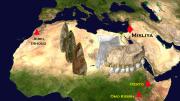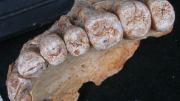Our modern human ancestors are thought to have begun migrating out of Africa about 100,000 years ago, but new evidence of human remains in a prehistoric cave finds that they left the continent at least 50,000 years earlier than that. The research, published in Science today, contributes to a growing body of findings—drawn from various investigative methods, including fossil dating and DNA evidence—suggesting that humans began to disperse across the planet much earlier than previously thought.
The discovery—an upper jawbone or maxilla with intact teeth—was found at Misliya, a prehistoric cave on Mount Carmel in northern Israel, an important site for excavations of early human remains during the last century. Three different dating methods put the bone’s age at 175,000 to 200,000 years. A large international research team, led by Tel Aviv University professor Israel Hershkovitz, analyzed the fossil and cave remains for evidence of the human inhabitants’ way of life. The presence of stone tools made using the Levallois technique, a distinctive stone knapping method, is consistent with those used by humans during the Middle Paleolithic, from 300,000 to 30,000 years ago.
“It is well-known from numerous studies that these were used mostly for the hunting of animals and processing their meat and skin (leather), as well as cutting plants,” says Daniella Bar-Yosef, a researcher at Tel Aviv University and an associate at Harvard’s Peabody Museum of Archaeology and Ethnology who is one of the co-authors of the paper. “However, the tools themselves do not determine the humans as moderns, because similar tools made by the Levallois technique are present in other sites that were occupied by Neanderthals.” Other dating methods were needed to distinguish the shape of the jawbone from the skeletons of Neanderthals and other, non-sapiens human species. One of Bar-Yosef’s research areas is molluscs, and, she says, the presence of mollusc shells at the site is consistent with what has been found among modern human remains at other Middle Paleolithic sites.
Prior to the discovery, the oldest known human remains outside Africa have been dated to 90,000 to 120,000 years ago; these were discovered beginning in 1929 at the Qafzeh and Es Skhul caves, also in northern Israel. Interestingly, DNA analyses of Neanderthal fossils in Europe indicate that Neanderthals intermixed with modern humans much earlier, over 200,000 years ago, suggesting that waves of human migration out of Africa could have taken place earlier still. “The H. sapiens fossils from Misliya, Skhul, and Qafzeh could therefore represent relatively late excursions of our species from Africa,” according to a commentary accompanying the research by Chris Stringer and Julia Galway-Witham, researchers at the Natural History Museum in London.
The findings contribute to a fuller picture of the arc of human migration out of Africa though the Middle East: “The way we understand it, there were several attempts of modern humans to leave Africa and disperse into Asia and Europe, and usually via the Levant. Or, in other words, there were several ‘waves’ of migration,” Bar-Yosef says. “Apparently, the earliest ones were not successful in that they did not spread throughout the other continents and reached only as far as the Levant, or Southwest Asia.” That no other human remains this old have been discovered, she adds, suggests this particular wave as well didn’t make it as a successful, long-term migration.










